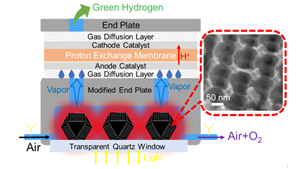News
Solar-powered system produces green H2 directly from air moisture
A team led by Prof. YIN Huajie from the Hefei Institute of Physical Science of the Chinese Academy of Sciences has developed a solar-powered system that produces green H2 directly from atmospheric moisture without relying on external water or energy sources.
Proton exchange membrane water electrolysis (PEMWE) technology is one of the primary routes for producing green H2, drawing significant attention due to its high efficiency and high-purity H2 output. However, the PEMWE process heavily relies on high-purity water as the reaction raw material, limiting its application in water-scarce regions. Atmospheric water harvesting (AWH), as an emerging approach to obtaining pure water, holds promise as a viable solution to the water shortage issue in the production of green H2.
In this study, the researchers developed a self-sustaining system that couples photothermal atmospheric water harvesting with proton exchange membrane electrolysis.
The system uses hierarchically porous carbon as an adsorbent to capture moisture from the air, which is evaporated by solar heat and fed into a custom-built electrolyzer for H2 production. The porous material is fabricated through template synthesis and calcination, followed by surface oxidation to improve water affinity.
It demonstrates remarkable performance. Even under low humidity conditions (as low as 20%), it maintains stable water collection and evaporation performance. Under 40% humidity, the system reached a H2 production rate of nearly 300 mL per hour with excellent cycle stability and long-term reliability.
Field tests further confirmed that it can continuously produce green H2 using only solar energy, with zero carbon emissions and no external energy input. This work provides a new pathway for sustainable H2 production in water-scarce regions, according to the team.
The research was supported by the National Natural Science Foundation of China and Collaborative Innovation Program of Hefei Science Center.


